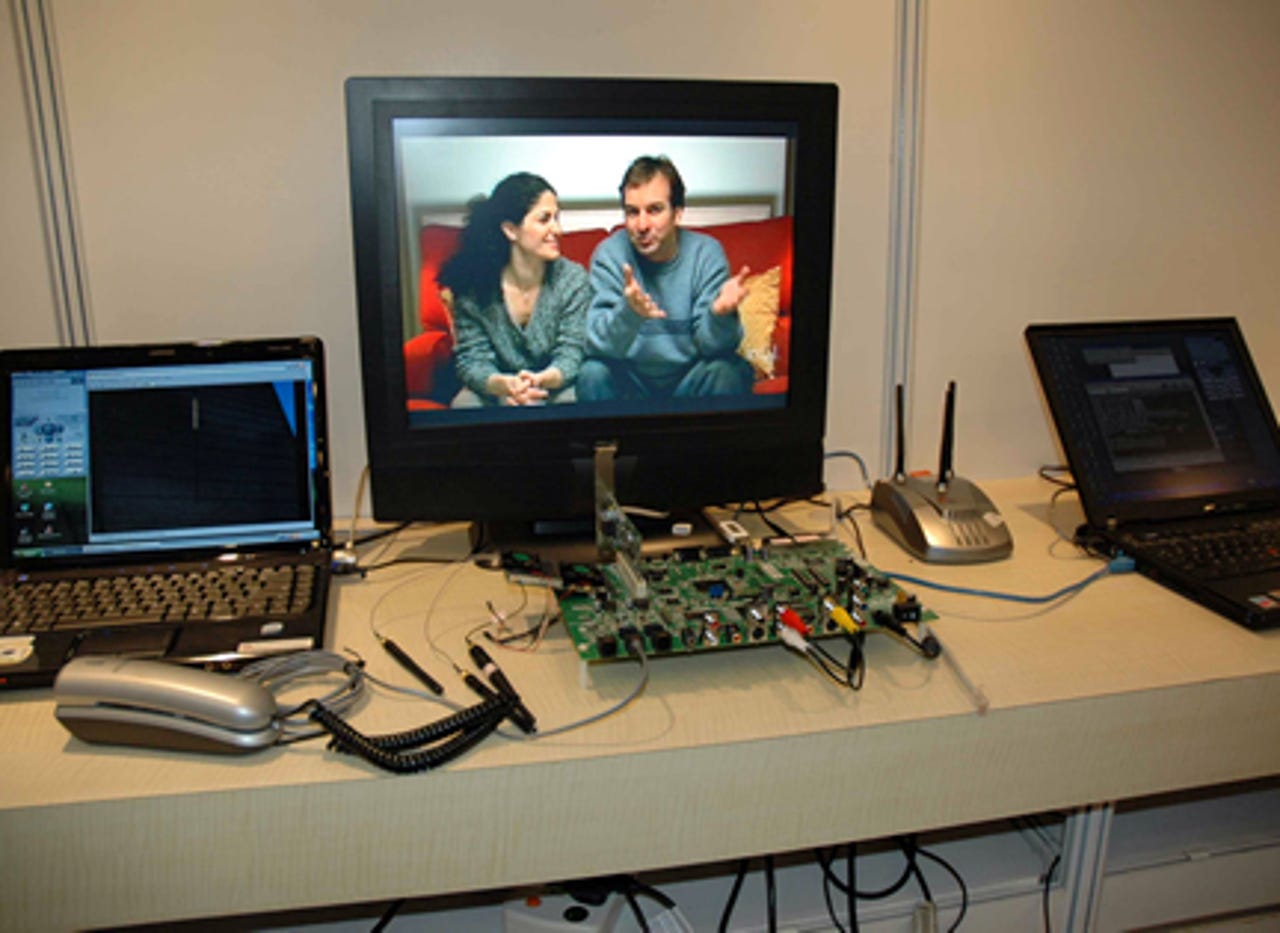Photos: Technology Showcase at IDF


That's 'Ntertainment
Is this the future of the unwired home? This breadboard uses pre-standard 802.11n to relay high-definition digital entertainment to notebooks around the house, and includes voice over IP so you can make or take phone calls from the same devices. It's very unfinished, but the miniature fans mounted on the radio modules show that the latest version of Wi-Fi comes at some cost in power consumption.
Photo credit: Rupert Goodwins
Scope envy
You know you're at the heart of geekland when Intel engineers stop and loudly admire displays like this. Not because it's showing an example of the most advanced radio engineering in the three square millimetre combined Wi-Fi and WiMax chip, but because it's using one of Sony's new digital video microscopes. 'We've got to have one of those!', exclaimed one engineer, adding 'How come China has it and we haven't?'
Photo credit: Rupert Goodwins
Wafer thin
This is not the first time 45nm wafers have been seen in captivity, but this 12in. collection of circuits could contain around seventy thousand billion transistors — considerably more than there are stars in the largest galaxies known to man. The difference between Intel and the cosmos is that Intel can make as many of these as it likes (within reason), and you're likely to have slivers of this silicon in a computer or other gizmos in the next couple of years.
Photo credit: Rupert Goodwins
Rattlesnake shake
Just like the snake after which it's modelled, this prototype notebook can shed its skin. Unlike your average serpent, though, this detachable wrap contains an electronic ink screen and ancillary electronics, so you can download an electronic book and read it with the main machine turned firmly off. The wrap is kept in place by magnetic latches and has a docking port; the idea is that you can re-skin your system as fashion dictates, or move your favourite active cover from computer to computer. No answer as yet to the elemental question: why are e-ink e-books always demonstrated with a selection from Sherlock Holmes?
Photo credit: Rupert Goodwins
Instant WiMAX
The Airspan EasyST WiMax/Wi-Fi modem is designed to be a self-installable device that you plug into the mains to give you an instant home hotspot courtesy of your WiMAX service provider. The large blue cylinder contains the antenna, which locates and focuses on the provider's base station, which can be up to 15km away if you've got line of sight, or 1 to 2 km away if you're in a built-up area. That will give you 10 megabits a second — if you're the only user in the segment, and if you've got a WiMAX provider in the first place. That's unlikely to happen soon in Europe, which Intel admits is the most difficult area for the new technology — we've got lots of other, cheaper options.
Photo credit: Rupert Goodwins
Shrink rap
Meanwhile, Intel keeps shrinking its wireless components: this small card contains a complete multi-band WiMAX transceiver and the wherewithal to link it to Wi-Fi. The main problem the company faces is in persuading these and other radio standards — GPS, mobile, Bluetooth, digital television, ultrawideband and whatever else comes along, like 60GHz — not to interfere with each other in the small space and limited power environment of an average notebook.
Photo credit: Rupert Goodwins
Awesome display
One of the most instantly arresting sights at the showcase was a selection of Samsung SDI's active-matrix organic LED displays. These were showing full-motion video in screens up to 4in. across — screens with quite stunning contrast, brightness and saturated colours. Once you've seen one of these demonstrated, nothing else can quite compare. But the most impressive aspect is their remarkable thinness: they're a microscopic sheet of patterned plastic sandwiched between two glass plates, so they can be awesomely anorexic...
Photo credit: Rupert Goodwins
Thin is in
.... as this demonstrates. OLEDs need no backlight or extra reflective layers, and can theoretically be made in sizes as big as the glass can manage. The technology's been a long time coming, but it looks as though the long development effort will pay off. Just as a bonus, they're also much more efficient than other self-illuminating displays: they need no backlight, and a pixel that's off consumes no power.
Photo credit: Rupert Goodwins
UMPCs ape the PSP
Here's another view of one of the next-generation UMPCs, featuring Intel's shortly-to-be-announced Mobile 2007 processor. This one is designed to be held in both hands, rather like Sony's Playstation Portable (PSP), although it's much plumper and more ungainly. When asked about the resemblance to the PSP, one Intel engineer on the project said that the generation after this would be able to fit into practically the same size and shape as Sony's lissom toy.
Photo credit: Rupert Goodwins
On the one hand...
This is a mock-up of a curious idea — a tablet with a keyboard stuck to one end. The layout is designed to be easy to learn and to offer fast typing using just one hand (other versions included a miniaturised variant on a mobile phone and a larger layout for use with a PC). It's no replacement for QWERTY, but for those times when you've got no alternative but to be monodexterous, it might find its niche.
Photo credit: Rupert Goodwins